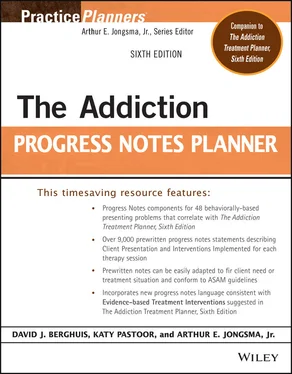The Addiction Progress Notes Planner
Здесь есть возможность читать онлайн «The Addiction Progress Notes Planner» — ознакомительный отрывок электронной книги совершенно бесплатно, а после прочтения отрывка купить полную версию. В некоторых случаях можно слушать аудио, скачать через торрент в формате fb2 и присутствует краткое содержание. Жанр: unrecognised, на английском языке. Описание произведения, (предисловие) а так же отзывы посетителей доступны на портале библиотеки ЛибКат.
- Название:The Addiction Progress Notes Planner
- Автор:
- Жанр:
- Год:неизвестен
- ISBN:нет данных
- Рейтинг книги:5 / 5. Голосов: 1
-
Избранное:Добавить в избранное
- Отзывы:
-
Ваша оценка:
- 100
- 1
- 2
- 3
- 4
- 5
The Addiction Progress Notes Planner: краткое содержание, описание и аннотация
Предлагаем к чтению аннотацию, описание, краткое содержание или предисловие (зависит от того, что написал сам автор книги «The Addiction Progress Notes Planner»). Если вы не нашли необходимую информацию о книге — напишите в комментариях, мы постараемся отыскать её.
The Addiction Progress Notes Planner, Sixth Edition
Addictions Treatment Planner, Sixth Edition
Addiction Treatment Planner, Sixth Edition
The Addiction Progress Notes Planner
The Addiction Progress Notes Planner — читать онлайн ознакомительный отрывок
Ниже представлен текст книги, разбитый по страницам. Система сохранения места последней прочитанной страницы, позволяет с удобством читать онлайн бесплатно книгу «The Addiction Progress Notes Planner», без необходимости каждый раз заново искать на чём Вы остановились. Поставьте закладку, и сможете в любой момент перейти на страницу, на которой закончили чтение.
Интервал:
Закладка:
INTERVENTIONS IMPLEMENTED
1 Build Trust and Establish Rapport (1) *Caring was conveyed to the client through support, warmth, and empathy.The client was provided with nonjudgmental support and a level of trust was developed.The client was urged to feel safe in expressing experiences as an ACA.The client began to express feelings more freely as rapport and trust level have increased.The client has continued to experience difficulty being open and direct about the expression of painful feelings; the client was encouraged to use the safe haven of therapy to express these difficult issues.
2 Focus on Strengthening Therapeutic Relationship (2)The relationship with the client was strengthened using empirically supported factors.The relationship with client was strengthened through the implementation of a collaborative approach, agreement on goals, demonstration of empathy, verbalization of positive regard, and collection of client feedback.The client reacted positively to the relationship-strengthening measures taken.The client verbalized feeling supported and understood during therapy sessions.Despite attempts to strengthen the therapeutic relationship the client reports feeling distant and misunderstood.The client has indicated that sessions are not helpful and will be terminating therapy.
3 Explore Feelings of Powerlessness (3)The client was probed for childhood experiences of powerlessness while growing up in an alcoholic home.The client was asked to explore similarities between feelings of childhood powerlessness and feelings when abusing chemicals.The client was assigned to complete the Step 1 exercise in The Alcoholism and Drug Abuse Client Workbook (Perkinson).The client was assisted in comparing and contrasting adult feelings of powerlessness connected to substance abuse with historical feelings of powerlessness associated with growing up in an alcoholic home.The client was probed for childhood experiences of powerlessness but denied any concerns in this area.
4 Teach Connection Between Childhood and Addiction (4)The client was taught about the increased likelihood to repeat addictive behavior because of growing up in an addictive family.The client was taught specific syndromes of thought and behavior that often repeat from one addictive generation to another.The client was provided with specific examples of the repetition of addiction from one generation to another.The client was encouraged to identify the connection between childhood experiences and the likelihood of repeating behavior.The client denied any connection between childhood experiences and the likelihood of repeating those types of behaviors; the client was reminded to be aware of this connection.
5 Administer Assessment for ACA Traits (5)The client was administered psychological instruments designed to objectively assess the strength of traits associated with being an adult child of an alcoholic.The Children of Alcoholics Screening Test was administered to the client.The client has completed the assessment of adult-child-of-an-alcoholic traits, but minimal traits were identified; these results were reported to the client.The client has completed the assessment of adult-child-of-an-alcoholic traits, and significant traits were identified; these results were reported to the client.The client refused to participate in psychological assessment of adult-child-of-an- alcoholic traits, and the focus of treatment was turned toward this defensiveness.
6 Explore Dysfunctional Family Rules (6)The client explored the pattern of dysfunctional family rules from childhood.The client was asked to explore how dysfunctional family rules lead to chronic fear and an escape into addiction.The client was given support and affirmation regarding the chronic fear related to dysfunctional family rules.It was reflected to the client that they are continuing to exhibit emotional distress and a desire to escape into addiction.
7 Educate About ACA Rules (5)The client was taught the ACA rules for living (i.e., “don't talk, don't trust, don't feel”).The client was taught the connection between dysfunctional ACA rules and the impossibility of healthy relationships occurring.The client was reinforced for verbalizing an understanding of dysfunctional ACA rules and how these have affected relationships.The client denied any pattern of ACA rules or dysfunctional current relationships and was urged to monitor these patterns.
8 Develop Connection Between ACA Traits and Addiction (8)The client was directed to list five ways in which ACA traits have led to addiction.The client was assigned “Addressing ACA Traits in Recovery” from the Addiction Treatment Homework Planner (Lenz, Finley, & Jongsma).The client was assisted in identifying how their ACA traits have led to addiction.The client has displayed greater insight into the connection between their ACA traits and addiction and was reinforced for this growth.The client has not completed assignments regarding understanding codependent behaviors and was redirected to do so.
9 Identify ACA Traits (9)The client was assisted in clarifying ACA traits and the relationship between ACA traits and addiction.The client clearly understood the role that ACA traits have played within their functioning and how that has contributed to the dynamics of their addiction; this insight was reinforced.The client verbalized an understanding of ACA traits and how they have an impact on current functioning in relationships; this insight was reinforced.The client denied the connection between ACA traits and addictive behavior or relationship conflicts and was urged to monitor for this dynamic.
10 Assess Level of Insight (10)The client's level of insight toward the presenting problems was assessed.The client was assessed in regard to the syntonic vs. dystonic nature of their insight about the presenting problems.The client was noted to demonstrate good insight into the problematic nature of the behavior and symptoms.The client was noted to be in agreement with others’ concerns and is motivated to work on change.The client was noted to be ambivalent regarding the problems described and is reluctant to address the issues as a concern.The client was noted to be resistant regarding acknowledgment of the problem areas, is not concerned about them, and has no motivation to make changes.
11 Assess for Correlated Disorders (11)The client was assessed for evidence of research-based correlated disorders.The client was assessed in regard to the level of vulnerability to suicide.The client was identified as having a comorbid disorder, and treatment was adjusted to account for these concerns.The client has been assessed for any correlated disorders, but none were found.
12 Assess for Culturally Based Confounding Issues (12)The client was assessed for age-related issues that could help to better understand their clinical presentation.The client was assessed for gender-related issues that could help to better understand their clinical presentation.The client was assessed for cultural syndromes, cultural idioms of distress, or culturally based perceived causes that could help to better understand their clinical presentation.Alternative factors have been identified as contributing to the client's currently defined “problem behavior” and these were taken into account in regard to their treatment.Culturally based factors that could help to account for the client's currently defined “problem behavior” were investigated, but no significant factors were identified.
13 Assess Severity of Impairment (13)The severity of the client's impairment was assessed to determine the appropriate level of care.The client was assessed in regard to impairment in social, relational, vocational, and occupational endeavors.It was reflected to the client that their impairment appears to create mild to moderate effects on the client's functioning.It was reflected to the client that their impairment appears to create severe to very severe effects on the client's functioning.The client was continuously assessed for the severity of impairment, as well as the efficacy and appropriateness of treatment.
Читать дальшеИнтервал:
Закладка:
Похожие книги на «The Addiction Progress Notes Planner»
Представляем Вашему вниманию похожие книги на «The Addiction Progress Notes Planner» списком для выбора. Мы отобрали схожую по названию и смыслу литературу в надежде предоставить читателям больше вариантов отыскать новые, интересные, ещё непрочитанные произведения.
Обсуждение, отзывы о книге «The Addiction Progress Notes Planner» и просто собственные мнения читателей. Оставьте ваши комментарии, напишите, что Вы думаете о произведении, его смысле или главных героях. Укажите что конкретно понравилось, а что нет, и почему Вы так считаете.












